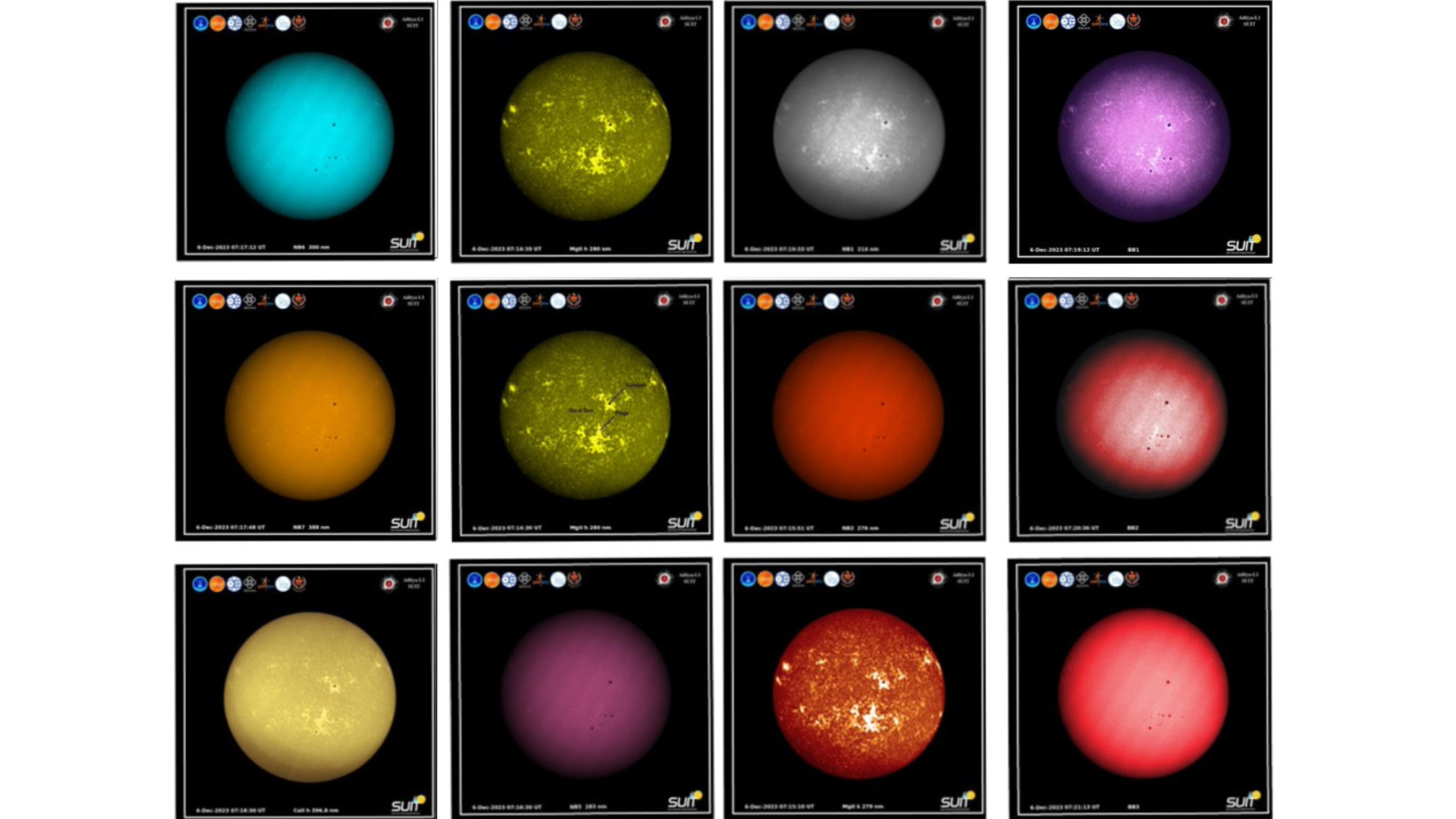India's Aditya-L1 solar observatory captures 1st gorgeous views of the sun (images)
The spacecraft has exited Earth's sphere of influence and is about a month away from reaching its cosmic accommodations at L1.

An instrument onboard India's first sun-studying observatory has officially opened its scientific eyes and sent home beautiful images of our star.
The pictures, captured earlier this week by a payload named SUIT (short for Solar Ultraviolet Imaging Telescope), reveal a handful of features on the sun's surface, including a few sunspots, a solar "plage" and some silent, inactive areas.
It is a "lifetime opportunity to conceive a space telescope & get to see its first light observations," Durgesh Tripathi, SUIT's principal investigator, said in a post on X (formerly Twitter) on Friday (Dec. 8).
Related: India's Aditya-L1 sun probe spots 1st high-energy solar flare
Scientists turned on the instrument on Nov. 20, according to a statement by the Indian Space Research Organisation (ISRO), which is operating the Aditya-L1 solar observatory in collaboration with multiple institutions located in Ahmedabad, Pune and Kerala.
Aditya-L1 Mission:The SUIT payload captures full-disk images of the Sun in near ultraviolet wavelengthsThe images include the first-ever full-disk representations of the Sun in wavelengths ranging from 200 to 400 nm.They provide pioneering insights into the intricate details… pic.twitter.com/YBAYJ3YkUyDecember 8, 2023
The sun, of course, is a roiling ball of plasma. So rather than a solid, rocky surface like Earth's, the sun's visible "surface" is really a thin envelope of hydrogen and helium called photosphere. It is about 62 miles (100 kilometers) thick and home to sunspots, or dark, planet-size regions of intense magnetic fields from which powerful solar flares blast out. Sometimes, these plasma jets travel toward us, like those that spurred a recent "cannibal" solar storm that initiated gorgeous auroras around the world.
Aditya-L1's latest images capture four clear sunspots, including one very close to the sun's equator. Our star appears to be calmer to its left, labeled in the image as "quiet sun." Below the equator, you'll notice another feature called the plage, a very hot region usually seen in the chromosphere, which is the layer of the sun's atmosphere above the photosphere but underneath its corona.
Breaking space news, the latest updates on rocket launches, skywatching events and more!
The Aditya-L1 spacecraft lifted off on Sept. 2 from India's spaceport in Sriharikota on a four-month journey to L1 orbit, a vantage point in space approximately 1 million miles (1.5 million kilometers) from Earth. From this region, the probe can observe the sun continuously and also remain somewhat stable by using minimal fuel and requiring just a few orbital maneuvers.
The spacecraft flung past the sphere of Earth's gravitational influence in late September; it will reach its final cosmic accommodations later this month or early next. Then, its seven science instruments are expected to begin studying how solar wind particles behave after blasting from the sun, while also monitoring our star for upcoming solar flares.
The mission team has started switching on other payloads onboard Aditya-L1 too. Last week, for instance, ISRO announced the Aditya Solar wind Particle Experiment (ASPEX) instrument, meant to study the composition of solar wind by in-situ observations, was performing as expected. On Friday (Dec. 8), another payload designed to monitor solar wind was also turned on and declared to be in good health, the space agency said in a different statement.
Scientists hope to use data from this mission to predict solar flare activity and their companions, coronal mass ejections.

Sharmila Kuthunur is an independent space journalist based in Bengaluru, India. Her work has also appeared in Scientific American, Science, Astronomy and Live Science, among other publications. She holds a master's degree in journalism from Northeastern University in Boston.
